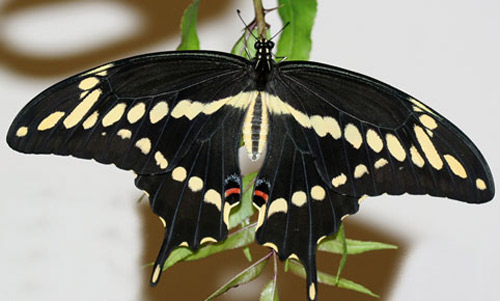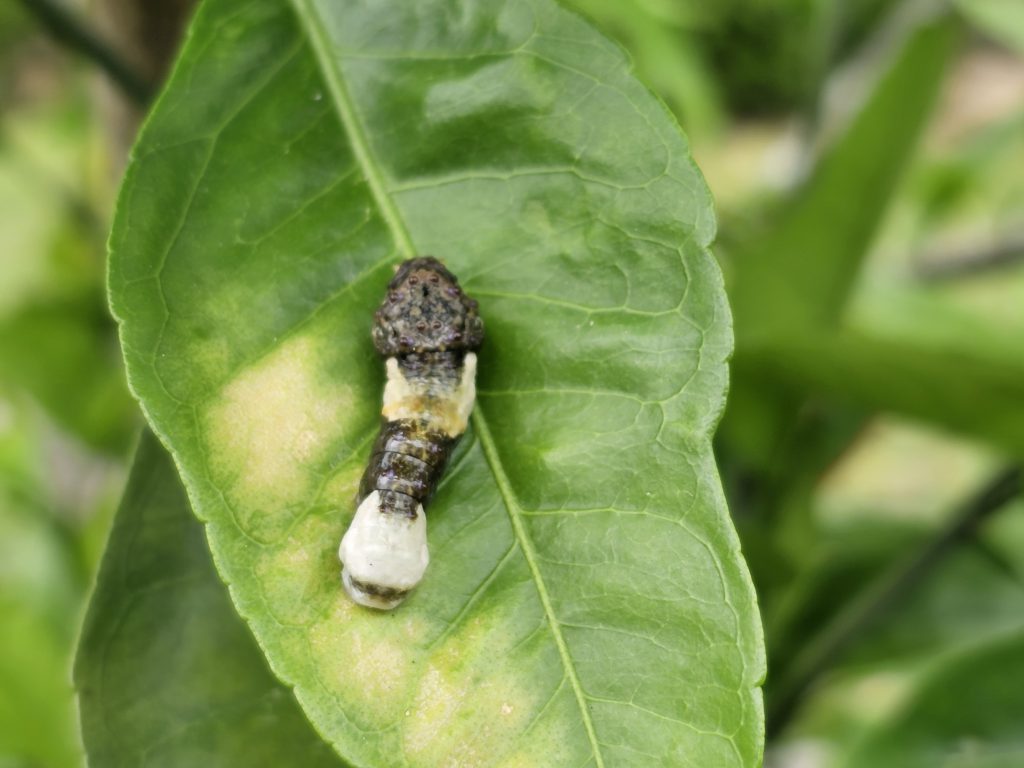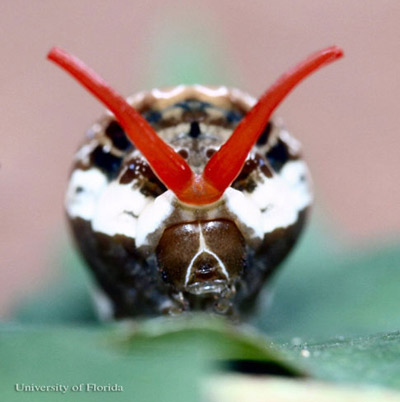Throughout the year, people with citrus trees of any sort may notice some damage to the leaves. Chewing damage, which leaves pieces of the leaf missing, is a common sight. The likely culprit for this type of damage is an insect that is very common in our area, but seems to have multiple personalities!
The adult form of this peculiar creature is the giant swallowtail butterfly, Papilio cresphontes Cramer. A large black-and-yellow butterfly, it is found throughout the country east of the Rocky Mountains, and is present in north Florida most months of the year. Adults spend their days as many other butterflies do, flitting from flower to flower in search of nectar. They are attracted to a wide variety of blossoms, pollinating as they go.

The giant swallowtail butterfly. Photo courtesy of Donald Hall, University of Florida
Females lay tiny round eggs individually on the surface of plant leaves. Though their larvae may eat numerous types of leaves, one of their favorites seems to be those of citrus trees. This means that though the adults may be considered beneficial as pollinators, their caterpillars are often thought of as pests.

Bird poop or caterpillar? The orange dog caterpillar is, in fact, a caterpillar.
Similarly, the beauty of the adult butterfly is quite different than the appearance of their younger selves. The caterpillar of the giant swallowtail, often called the ‘orange dog’ caterpillar, relies on camouflage to keep itself safe. Even with this it displays multiple personalities, so to speak. Larvae of any age may be mistaken as bird droppings on a leaf. Their irregular patches of white and brown make them look like the leavings of a passing avian, which predators are probably likely to pass over. Older caterpillars have another trick up their sleeve, with markings on their head that mimic the head of a snake. Disturb one enough and it may even flash a forked, bright orange protuberance called the osmeterium, which may resemble the tongue of a snake. This gland also emits a musky odor to make the insect even less attractive to potential predators.

Snake or caterpillar? The osmeterium might look like a snake’s tongue, but don’t be fooled. Photo courtesy of Donald Hall, University of Florida
Whether wearing a beautiful, ugly, or scary face, these insects are here to stay. Thankfully, they don’t often do enough damage to citrus trees for homeowners to worry about. Young trees in danger of being defoliated may need some protection, but an established tree can lose a leaf or three with no issues.
If control is called for, hand-picking the caterpillars is a viable option, as long as the tree is small enough to reach the branches. A product called Bt, short for Bacillus thuringiensis, is another option. Applied to the leaves, this insecticide only affects caterpillars, and shouldn’t harm other pollinators.
For more information, see our EDIS publication: https://edis.ifas.ufl.edu/publication/IN134 or contact your local Extension office.
- The Eastern Lubber Grasshopper - June 5, 2025
- Grass is Growing; Time for Mowing - April 30, 2025
- Variegation, Viruses, and You - June 27, 2024
